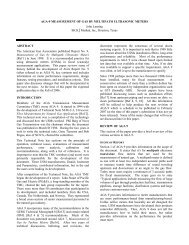FUNDAMENTALS OF ORIFICE METERING
FUNDAMENTALS OF ORIFICE METERING
FUNDAMENTALS OF ORIFICE METERING
You also want an ePaper? Increase the reach of your titles
YUMPU automatically turns print PDFs into web optimized ePapers that Google loves.
tube. Therefore, most consider 250 microinches surface<br />
roughness to be the maximum roughness for a quality meter<br />
tube.<br />
Meter Tube Lengths<br />
The flow of fluid through elbows, tees, and valves will cause<br />
turbulence, which adversely effects the fluid measurement.<br />
For accurate flow measurement, the fluid should enter the<br />
orifice plate free from swirls and cross currents.<br />
In order to achieve the desired flow profile, adequate<br />
upstream and downstream straight pipe is required and<br />
/ or flow conditioners such as straightening vanes.<br />
The use of flow conditioners (straightening vanes) will also<br />
reduce turbulence within the meter tube while allowing<br />
shorter lengths of straight pipe.<br />
Research continues on straightening vanes in regard to effect<br />
location and relationship to meter tube lengths.<br />
AGA 3 includes five commonly used piping<br />
configurations and has defined minimum lengths 'of<br />
straight pipe preceding and following the orifice plate<br />
as shown in the example in figure 7.<br />
Figure 7<br />
There are to be no pipe connections within the minimum<br />
amount of straight pipe with the exception of the pressure<br />
taps, temperature probes, and/or straightening vane<br />
attachments<br />
The meter tube lengths recommended by the third edition of<br />
AGA 3 have not changed from the second edition. There is<br />
considerable research being conducted regarding minimum<br />
lengths of meter tube pipe required.<br />
MeterTube Inspection and Calibration<br />
Upon completion of fabrication, the meter tube shall be<br />
checked for compliance with standards and document the<br />
calibration results.<br />
It should be noted that the third edition does not require<br />
maintaining diameter measurements within published pipe<br />
diameters as per previous editions of AGA 3. The practice<br />
of using published diameters and coefficients resulted in<br />
inherent flow computation error since it is unlikely that<br />
meter tubes are manufactured exactly the same diameter as<br />
the published pipe diameter.<br />
The intent of the third edition AGA 3 is to enhance the<br />
accuracy of the meter tube by using actual, measured<br />
diameters.Thus, eliminating flow computation errors due to<br />
inaccurate diameter ratios.<br />
DIAMETER MEASUREMENTS &TOLERANCES<br />
Meter Tube Diameter<br />
The measured diameter of the meter tube shall be<br />
determined by taking a minimum of four equally spaced<br />
diameter measurements made in a plane one (1) inch from<br />
the upstream face of the orifice plate. The average of these<br />
four or more measurements is defined as the measured meter<br />
tube diameter. Check measurements should be made at two<br />
or more additional cross sections. These check<br />
measurements should be taken at points that indicate the<br />
maximum and minimum diameters. One measurement<br />
should be taken at least two (2) pipe diameters upstream of<br />
the orifice plate or past the plate holder or weld, whichever<br />
is greater. Individual check measurements shall be made on<br />
the downstream section of the meter tube in a plane one (1)<br />
inch from the down- stream face of the orifice plate.<br />
Additional measurements shall be taken on at least two other<br />
cross-sections in the downstream section of the meter tube.<br />
The check measurements are to verify uniformity but do not<br />
become part of the mean meter tube diameter. The absolute<br />
value of the percentage differences between the measured<br />
meter tube internal diameter and any individual diameter<br />
measurement within a distance of one meter tube diameter<br />
on the upstream side of the orifice plate shall not exceed<br />
0.25 percent of measured diameter (Dm)(See figure 8).




